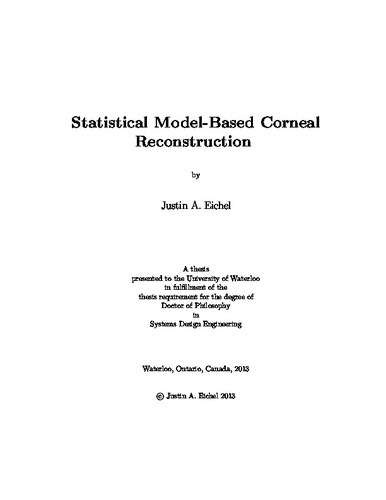| dc.description.abstract | Precise measurements of corneal layer thickness are required to treat, evaluate risk of, and determine the progression of pathologies within the eye. The thickness measurements are typically acquired as 2d images, known as tomograms, from an optical coherence tomography (OCT) system. With the creation of ultra-high resolution OCT (UHROCT), there is active research in precisely measuring, in vivo, previously unresolvable corneal structures at arbitrary locations within the cornea to determine their relationship with corneal health.
In order to obtain arbitrary corneal thickness measurements, existing reconstruction techniques require the cornea to be densely sampled so that a 3d representation can be interpolated from a stack of tomograms. Unfortunately, tomogram alignment relies solely on image properties such as pixel intensity, and does not constrain the reconstruction to corneal anatomy. Further, the reconstruction method cannot properly compensate for eye-motion. The deficiencies due to eye-motion are exacerbated due to the amount of time required in a single imaging session to acquire a sufficient number of tomograms in the region of interest.
The proposed methodology is the first to incorporate models of the anatomy and the imaging system to address the limitations of existing corneal reconstruction methods. By constructing the model in such a way as to decouple anatomy from the imaging system, it becomes less computationally expensive to estimate model parameters. The decoupling provides an iterative methodology that can allow additional constraints to be introduced in the future. By combining sparsely sampled UHROCT measurements with a properly designed corneal model, reconstruction allows researchers to determine corneal layer thicknesses at arbitrary positions in both sampled and unsampled regions.
The proposed methodology demonstrates an approach to decouple anatomy and physiology from measurements of a cornea, allowing for characterization of pathologies through corneal thickness measurements. Another significant contribution resulting from the corneal model allows five of the corneal layer boundaries to be automatically located and has already been used to process thousands of UHROCT tomograms. Recent studies using this method have also been used to correlate contact-lens wear to hypoxia and corneal layer swelling. While corneal reconstruction represents the main application of this work, the reconstruction methodology can be extended to other medical imaging domains and can even represent temporal changes in tissue with minor modifications to the framework. | en |

